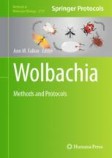Search
Search Results
-
Turnip yellows virus variants differ in host range, transmissibility, and virulence
Turnip yellows virus (TuYV; family Solemoviridae , genus Polerovirus , species Turnip yellows virus ) is a genetically diverse virus that infects a...

-
Recombination of variable and host range regions of glycoprotein gp85 in different avian leukosis virus subgroup K isolates
Given the high prevalence of avian leukosis virus subgroup K (ALV-K) in chickens in China, the positive rate of ALV-K in local chickens in Henan...

-
Variants of a putative baseplate wedge protein extend the host range of Pseudomonas phage K8
BackgroundNarrow host range is a major limitation for phage applications, but phages can evolve expanded host range through adaptations in the...

-
Host-Directed Antiviral Therapy
Most of the antiviral drugs developed so far have been specifically designed to target particular pathogens and their unique viral pathways. However,...
-
Emerging SARS-CoV-2 variants of concern potentially expand host range to chickens: insights from AXL, NRP1 and ACE2 receptors
BackgroundThe possibilities of cross-species transmission of SARS-CoV-2 variants of concern (VOCs) between humans and poultry species are unknown....

-
Host range of strand-biased circularizing integrative elements: a new class of mobile DNA elements nesting in Gammaproteobacteria
BackgroundThe strand-biased circularizing integrative elements (SEs) are putatively non-mobilizable integrative elements for transmitting...

-
Vector species, pasture legume host range, and impact on grain legumes of an Australian soybean dwarf virus isolate
Soybean dwarf virus (SbDV; family Tombusviridae , genus Luteovirus , species Soybean dwarf virus ) can cause damaging disease epidemics in cultivated...

-
Host–Microbe Interactions and Infectious Disease
Infectious disease is defined as the damage that occurs in a host because of a host–microbe interaction, where damage is the disruption of the normal...
-
Screening Host Genomic Data for Wolbachia Infections
Less than a decade ago, the production of Wolbachia genomic assemblies was tedious, time-consuming, and expensive. The production of Wolbachia...
-
The wild life of ticks: Using passive surveillance to determine the distribution and wildlife host range of ticks and the exotic Haemaphysalis longicornis, 2010–2021
BackgroundWe conducted a large-scale, passive regional survey of ticks associated with wildlife of the eastern United States. Our primary goals were...

-
Systemic Oncosphere: Host Endocrine System
Host endocrine system is a complicated network of glands, that precisely secrete hormones, chemicals or peptides to regulate most, if not all host...
-
Replication of cowpox virus in macrophages is dependent on the host range factor p28/N1R
Zoonotic orthopoxvirus infections continue to represent a threat to human health. The disease caused by distinct orthopoxviruses differs in terms of...

-
Programmed Necrosis in Host Defense
Host control over infectious disease relies on the ability of cells in multicellular organisms to detect and defend against pathogens to prevent...
-
African Swine Fever Virus Host–Pathogen Interactions
African swine fever virus is a complex double-stranded DNA virus that exhibits tropism for cells of the mononuclear phagocytic system. Virus...
-
Visualisation of Host–Pathogen Communication
The core of biomedical science is the use of laboratory techniques to support the diagnosis and treatment of disease in clinical settings. Despite...
-
Evaluating the mosquito host range of Getah virus and the vector competence of selected medically important mosquitoes in Getah virus transmission
BackgroundThe Getah virus (GETV) is a mosquito-borne Alphavirus (family Togaviridae ) that is of significant importance in veterinary medicine. It...

-
Replacement of P1 of soybean mosaic virus with P1 of clover yellow vein virus has no impact on virus viability and host specificity
Potyvirus genomes are expressed as polyproteins that are autocatalytically cleaved to produce 10 to 12 multifunctional proteins, among which P1 is...

-
Dengue virus pathogenesis and host molecular machineries
Dengue viruses (DENV) are positive-stranded RNA viruses belonging to the Flaviviridae family. DENV is the causative agent of dengue, the most rapidly...

-
Studying Virus-Host Interactions with CRISPR Technology
The mosquito-borne West Nile virus (WNV) poses a great threat to public health as no vaccine or specific antiviral treatment is available. Exploring...
-
Bimolecular Fluorescence Complementation (BiFC) in Host–Virus Interactions
Bimolecular fluorescence complementation (BiFC) is an assay widely used for studying protein–protein interactions and determining the subcellular...
